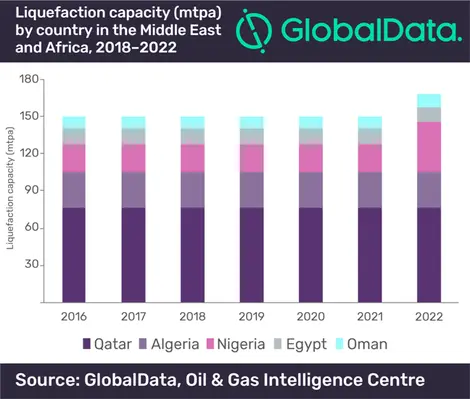Nigeria is set to have the highest liquefaction capacity additions while Kuwait and Turkey will have highest regasification capacity additions among all countries in the Middle East and Africa’s LNG industry between 2018 and 2022, according to GlobalData, a leading data and analytics company
The company’s report “LNG Industry Outlook in Middle East and Africa to 2022” forecasts total liquefaction capacity in the Middle East and Africa to increase from 172.7 million tonnes per annum (mtpa) in 2017 to 234 mtpa in 2022 at an average annual growth rate (AAGR) of 6.1 per cent. Similarly, the total regasification capacity is expected to grow from 3,007.6 bcf in 2017 to 5,895 bcf in 2022 at an AAGR of 13.5 per cent.
Nigeria will lead the Middle East and Africa in terms of liquefaction capacity additions. The country will have the highest liquefaction capacity additions of 18 mtpa, increasing from 22 mtpa in 2017 to 40 mtpa by 2022 at an AAGR of 12 per cent. The country is expected to spend US$25.26bn on new build liquefaction terminals during the outlook period.
Soorya Tejomoortula, oil and gas analyst at GlobalData, explained, “Nigeria is expanding its liquefaction capacity to capture increasing global demand for natural gas. The country aims to become one of the major suppliers of LNG globally.”
In terms of regasification capacity additions in the Middle East and Africa, 10 regasification terminals are expected to become operational between 2018 and 2022. The total planned regasification capacity in the Middle East and Africa in 2022 is expected to be 2,887.5 bcf.
Kuwait will lead the Middle East and Africa with total additions of 1071 bcf. The country’s regasification capacity will increase from 264.8 bcf in 2017 to 1,335.8 bcf in 2022 at an AAGR of 32.4 per cent. The country is expected to spend around US$2.9bn on the development of upcoming regasification terminals during the outlook period.

Tejomoortula added, “Kuwait is increasing its LNG regasification capacity to meet its growing domestic power demand. The country is grappling with chronic electricity shortages, which is threatening its economic development. The new LNG terminal will also generate business opportunities for the local companies and helps in promoting industrial growth in the country.”
Turkey will be the next highest country in the Middle East and Africa with planned regasification capacity additions of 392.7 bcf by 2022. The country is expected to spend about US$548.5mn on the development of new regasification terminals.
In terms of largest liquefaction terminal by capacity in the outlook period, Mozambique has the top planned LNG liquefaction terminal in the Middle East and Africa with a capex of US$15bn. The terminal is expected to start operations by 2022 with an expected capacity of 12 mtpa.
In terms of largest regasification terminal by capacity, Al-Zour terminal in Kuwait is the top planned LNG regasification terminal with a capacity of 1,071 bcf. The terminal is expected to come online by 2021 with an estimated capex of US$3.3bn.








